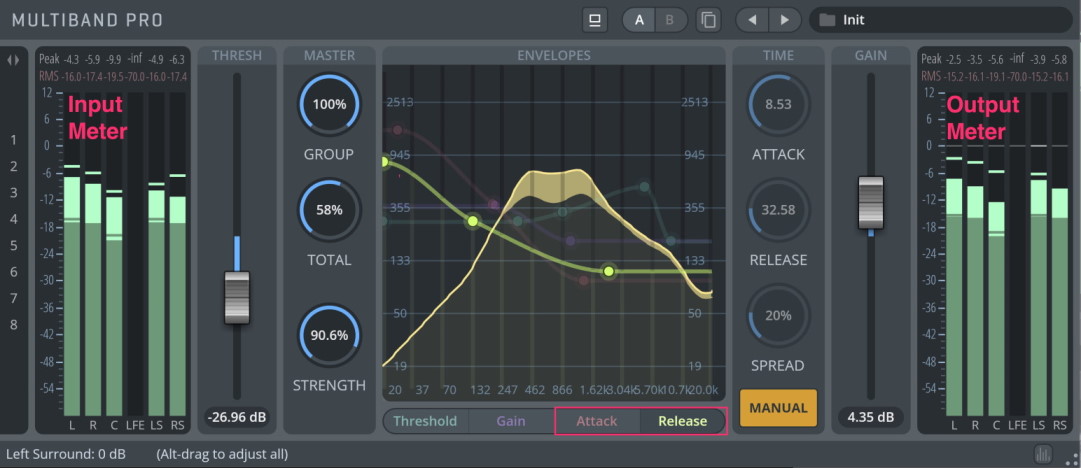The Multiband Pro is an advanced 12-band surround dynamics processor that features a refreshingly different approach to surround processing. The Multiband Pro internally operates as a dynamic equalizer, allowing for a more flexible multiband compression than what can be achievable with a more traditional crossover-filter network. Further, the process allows for zero-latency multiband compression.
The simplistic interface lets you focus on your musical results without any distraction from an excessive supply of overly detailed control elements.
Flexible graph editing and real-time visual feedback allows for intuitive control of your mix in any surround mixing situation.
The Multiband Pro will be a great asset in your mastering process, controlling the full frequency spectrum for all available signals.
Another common use of frequency-specific limiting/compression is de-essing. This allows you to control the sibilants of an audio signal without affecting lower frequencies.


The Multiband Pro, just like the Limiter Pro, allows for fine-grained control over the linking between audio channels. A stereo limiter usually has its channels linked, not to shift its panorama when peaks occur in only one of the two channels. Surround limiting has different requirements since limiting all channels the same way as done in a stereo limiter would sound unnatural. The Limiter Pro offers a group section, allowing to link the attenuation of channels into groups. To recreate the operation of a stereo compressor, one could thus set both input channels to the same group, then adjust the GROUP value to 100%, to achieve a full linking in the attenuation of both channels.
For surround purposes, it can be beneficial to link speaker pairs. In a 5.1 setup, you would then set L/R to the same group, and Ls/Rs to the same group, then adjust the GROUP knob to achieve the desired result.
The TOTAL knob acts as an additional group, which all channels are fed into. Combining GROUP linking for speaker pairs and TOTAL linking allows you to adjust your limiting for any surround format.
M/S processing is available for each channel pair (L/R, Ls/Rs etc.). Activating the M/S button for a channel pair M/S-encodes the channels before processing and M/S-decodes the channels after processing.
A few practical examples:
De-essing – vocal sibilants
Droning Bass control
Tightening up acoustic guitar

Shows the levels of all available input channels. Clicking on the numerical peak displays above the meters resets the peak values.
THRESH: Threshold sets the point at which the limiter starts to affect the input signal. Lowering the threshold setting has the effect of raising the output gain of the signal. The average level of the signal is increased while the limiter assures that the signal will not exceed the ceiling level.
GROUP: Group link. Controls the extent to which channel compression affects other channels within the same group. Assign and select groups in the group section window.
TOTAL: Total link, acts as an additional group. Controls the extent to which channel compression will be globally linked between all channels.
STRENGTH: Compression Strength. Amount of compression to apply, affecting Threshold and Gain, in %. Can be seen as a parallel compression mix feature.
0% is the uncompressed signal, and 100% means you hear only the compressed signal.
Set the envelopes for THRESHOLD and GAIN. If MANUAL is selected in the TIME Window, two additional envelopes can be edited: ATTACK and RELEASE. Double-click to create a new node, and use the lasso to select multiple nodes. Right-click to reset the selected envelope or to reset all envelopes.
ATTACK: Controls baseline attack time for the compressor (600 Hz reference). (0, 1-200 ms).
RELEASE: Controls baseline release time for the compressor (600 Hz reference).Controls how long it takes for the limiter to recover from attenuating the signal after it has dropped below the threshold. (10–5000 ms).
SPREAD: Attack / Release Scaler. Controls attack/release scale spread in relation to the band frequency. Higher values will shorten the attack time for the high frequencies while keeping a longer attack time for the low frequencies.
THRESHOLD CURVE: Double-click in the graph window to create a handle which will display the Gain and Frequency values.